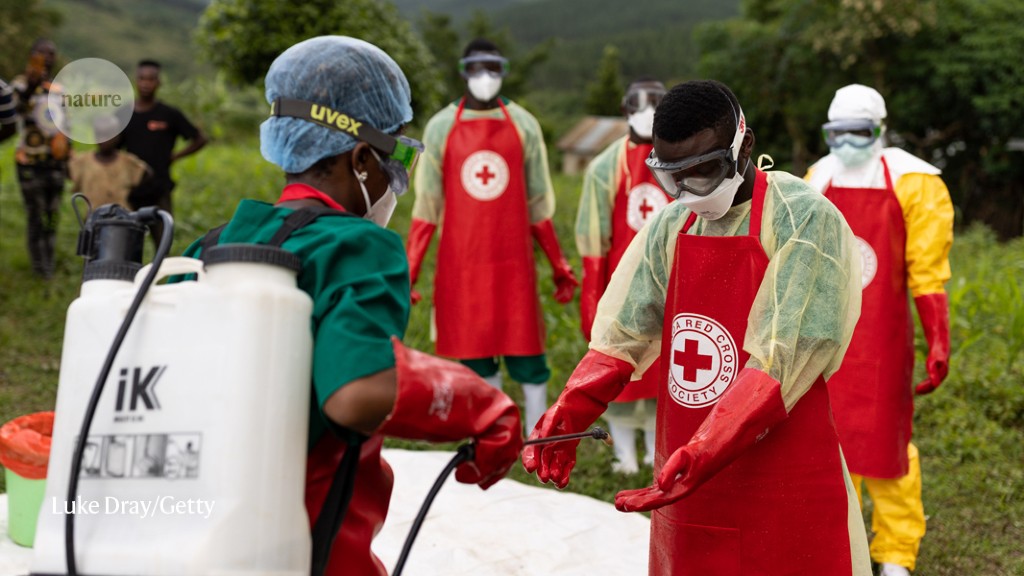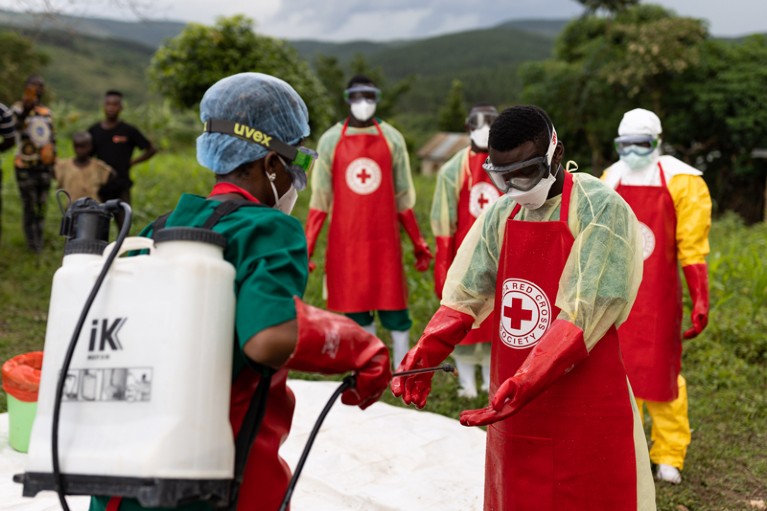There are no vaccines proved to protect against the type of Ebola currently circulating in Uganda.Credit: Luke Dray/Getty
COVID-19 vaccines that rely on mRNA technology are credited with transforming humanity’s fight against the coronavirus pandemic. The vaccines — one made by drug giant Pfizer with German biotech firm BioNTech, another by US pharmaceutical company Moderna — sped through clinical trials in just months and gained approval from major regulatory bodies less than a year after development began. Now, as Uganda battles a type of Ebola without proven vaccines, is an mRNA vaccine against the deadly virus on the cards? And would such a vaccine similarly transform the fight against Ebola?
There are two vaccines that are already proven to protect against Ebola: rVSV-ZEBOV (Ervebo), sold by Merck of Rahway, New Jersey, and Ad26.ZEBOV/MVA-BN-Filo (Zabdeno/Mvabea), sold by Johnson & Johnson, which is based in New Brunswick, New Jersey. But the vaccines are thought to protect against only one species of the virus: Zaire ebolavirus, which caused a large epidemic in West Africa between 2013 and 2016. There are no proven vaccines against Sudan ebolavirus, the species responsible for the current outbreak in Uganda, which has so far caused 132 infections and 51 deaths.
“Public health in Africa would benefit from further options,” says Heinz Feldmann, head of the US National Institute of Allergy and Infectious Diseases’ Laboratory of Virology in Hamilton, Montana, whose research contributed to the development of the existing Ebola vaccines.
Multiple protection
It would be ideal to have a vaccine that confers protection against multiple filoviruses — the family that includes Ebola virus and other pathogens that cause haemorrhagic diseases, such as Marburg virus — rather than having many separate vaccines, says Alex Bukreyev, a virologist at the University of Texas Medical Branch at Galveston. This would make vaccine distribution easier in poor and rural areas, because costly new vaccination campaigns wouldn’t be needed with every outbreak of a different Ebola species.
Both current Zaire ebolavirus vaccines use technology that relies on another active virus, which limits who can receive them. In most circumstances, Ervebo is approved for use only in people over 18 — and its side effects can be unpleasant. Johnson & Johnson’s regimen can be offered to people one year old and up, but it must be given in two doses, eight weeks apart, which is not ideal in a rapidly growing outbreak, Bukreyev says.
mRNA vaccines could remedy some of these challenges, says Norbert Pardi, a vaccinologist at the University of Pennsylvania in Philadelphia who specializes in mRNA technology. Unlike many other delivery platforms, mRNA vaccines don’t contain a virus. Rather, they use messenger RNA to encode key proteins that are found on the surface of a virus. When the mRNA enters a person’s cells, the cells start to make the protein, which triggers an immune response against the virus.
It’s easy to tweak the proteins that the mRNA encodes if a new species emerges, or to include different strands of mRNA to induce protection against multiple filoviruses at once. mRNA vaccines also have the benefit of “real-life evidence” of their safety and effectiveness when it comes to protecting against COVID-19: they have been administered to more than five billion people, Pardi says.
But COVID-19 and Ebola are very different diseases, Feldmann notes. The COVID-19 vaccines have been most effective in warding off severe infection and death, rather than preventing infection. This limitation is caused in part by how quickly immunity-evading variants have cropped up. It’s crucial that any Ebola vaccines help to prevent infection — as well as stopping severe disease — to avoid onward transmission and contain the lethal pathogen quickly, he says.
Ebola viruses don’t mutate nearly as fast as coronaviruses, so constant evolution of immune-evading variants is less of a concern, Pardi says. But it’s not clear whether a single mRNA shot can provide robust protection against infection with Ebola, says Feldmann. And, like the current Zaire ebolavirus vaccines, mRNA vaccines must be stored in cold conditions, which can complicate distribution.
Vaccine deal close
Answers might be coming soon, but probably not soon enough to help with the ongoing Ebola outbreak in Uganda. Moderna, which is based in Cambridge, Massachusetts, is close to securing a deal to develop an mRNA vaccine against Ebola and other filoviruses, according to news agency Bloomberg. But it’s unclear which species Moderna hopes to target — or whether it wants to develop one vaccine against multiple species.
There is some research suggesting that the mRNA approach might work to tackle Ebola. In 2017, Bukreyev and his colleagues found1 that two mRNA vaccine formulations produced immune responses in guinea pigs. None of the ten inoculated animals died after they were infected with a guinea pig–adapted ebolavirus, whereas all five control animals died or were killed due to severe sickness within ten days.
Bukreyev, who worked with Moderna on the study, says that if the deal goes through, it will probably take about three years of research in non-human primates to find out whether the vaccine is effective in the animals, and then human clinical trials will be needed.
Pardi hopes that Moderna and other firms will try the mRNA approach, and seek protection against multiple species. “We don’t know which Ebola virus will cause the next Ebola outbreak,” he says.







More News
I study artefacts left in prehistoric caves
How artificial intelligence is helping to identify global inequalities
Tackling ‘wicked’ problems calls for engineers with social responsibility